Eparchy of Banat
The Eparchy of Banat (Serbian: Банатска епархија or Banatska eparhija) is an ecclesiastical territory or eparchy of the Serbian Orthodox Church in the Banat region, Serbia. It is mostly situated in the autonomous province of Vojvodina, while the eparchy also include a small south-western part of Banat that belongs to the City of Belgrade as well as village of Ostrovo that belongs to the city of Požarevac. The seat of the eparchy is in Vršac.
Eparchy of Banat Банатска епархија Banatska eparhija | |
|---|---|
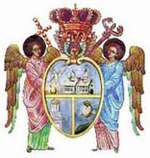 Coat of Arms of Eparchy of Banat | |
| Location | |
| Territory | Serbian Banat |
| Headquarters | Vršac, Serbia |
| Information | |
| Denomination | Eastern Orthodox |
| Sui iuris church | Serbian Orthodox Church Patriarchate of Peć (Serbia) |
| Established | 16th century |
| Language | Church Slavonic Serbian |
| Current leadership | |
| Bishop | Nikanor Bogunović |
| Map | |
-en.svg.png) | |
History

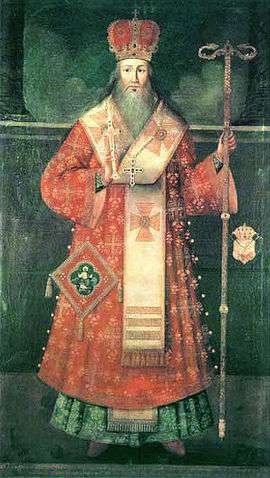
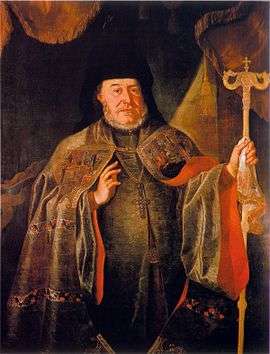
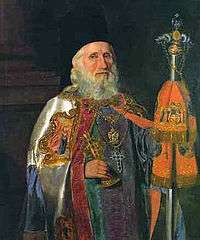
Serbian Orthodox Eparchy of Vršac was one of several eparchies created on the territory of Banat during the 16th century under the jurisdiction of the Serbian Patriarchate of Peć. By the time of the accession of Serbian patriarch Makarije I (1557), much of the Banat region was already conquered by the Turks who took over Temeswar in 1552.[1] Region was organized as a Turkish eyalet (province) named the Eyalet of Temeşvar.
During Turkish rule in the 16th and 17th centuries Banat was mainly populated by Serbs (also called Rascians) in the west and Vlachs (Romanians) in the east. In some historical sources it was referred to as Rascia and in others as Wallachia. Both Serbs and Romanians in Banat were Orthodox Christians. In some parts of Banat, Serbs were so numerous that the entire region was sometimes called "Rascia" ("the land of the Serbs", 1577).[2]
 Jurisdiction of Serbian Patriarchate in 16th and 17th century
Jurisdiction of Serbian Patriarchate in 16th and 17th century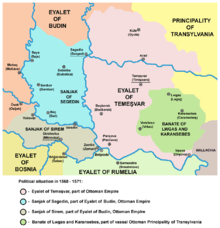 Eyalet of Temeşvar in 16th century
Eyalet of Temeşvar in 16th century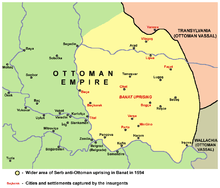 Uprising in Banat in 1594
Uprising in Banat in 1594
At the beginning of the Austro-Turkish War (1593-1606), in the spring of 1594, Serbs in Banat started an Uprising against Turkish rule. The local Romanians also participated in this uprising. Rebels took Vršac and various other towns in Banat and started negotiations with Prince of Transylvania. One of the leaders of the uprising was Serbian Orthodox Bishop Theodore.[3]
During Austro-Turkish War (1683-1699), Serbian patriarch Arsenije III sided with Austrians and appointed Spiridon Štibica as new Bishop of Vršac in 1694. Austrian troops took over parts of Banat and Eparchy of Vršac was officially recognized as a diocese of Serbian Orthodox Church by the charter of emperor Leopold I in 1695.
 Eyalet of Temeşvar in 17th century
Eyalet of Temeşvar in 17th century Eyalet of Temeşvar and surrounding regions in 1683
Eyalet of Temeşvar and surrounding regions in 1683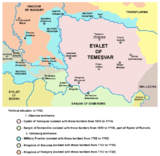 Eyalet of Temeşvar, from 1699 to 1716
Eyalet of Temeşvar, from 1699 to 1716
Under the Treaty of Karlowitz (1699) the Banat remained under Turkish administration. At the beginning of Austro-Turkish War (1716-1718), when Prince Eugene of Savoy took the Banat region from the Turks, Serbian Bishop of Vršac was Mojsije Stanojević. He sided with Austrians and secured official confirmation. After the Treaty of Passarowitz (1718), region became an Austrian province and was renamed as the Banat of Temeswar.
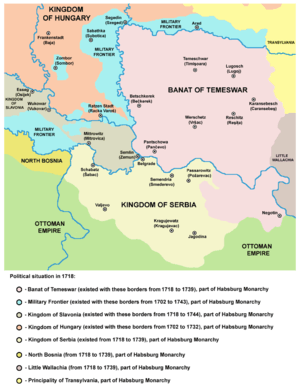 Banat of Temeswar, from 1718 to 1739
Banat of Temeswar, from 1718 to 1739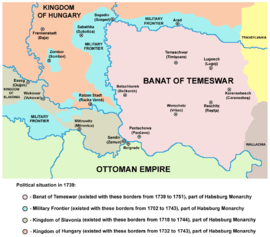 Banat of Temeswar, from 1739 to 1751
Banat of Temeswar, from 1739 to 1751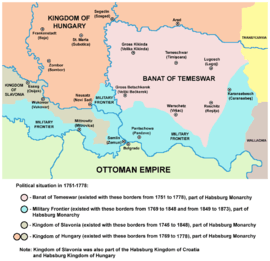 Banat of Temeswar, from 1751 to 1778
Banat of Temeswar, from 1751 to 1778
Eparchy of Vršac at first went under the jurisdiction of Serbian Orthodox Metropolitanate of Belgrade.[4] During Austro-Turkish War (1737-1739), Serbian Patriarch Arsenije IV sided with Austrians and made his residence in Sremski Karlovci. Eparchy of Vršac remained under the jurisdiction of Serbian Orthodox Metropolitanate of Karlovci, until 1920, when united Serbian Patriarchate was re-created.
During 18th and 19th century, prominent Serbian bishops of Vršac were Jovan Đorđević, who became Metropolitan of Karlovci in 1769 and Josif Rajačić who became Metropolitan of Karlovci in 1842 and Serbian Patriarch in 1848.
.png) Voivodeship of Serbia and Temes Banat (1849-1860)
Voivodeship of Serbia and Temes Banat (1849-1860) Residence of Serbian Orthodox Bishop in Vršac
Residence of Serbian Orthodox Bishop in Vršac Serbian Orthodox Cathedral of Saint Nicholas in Vršac
Serbian Orthodox Cathedral of Saint Nicholas in Vršac
During the First World War (1914-1918), many Serbian priests and parish councilors of the Eparchy of Vršac were persecuted, imprisoned or sent to concentration camps by the authorities of Austria-Hungary. The region of Banat was liberated and united with Serbia in 1918, becoming part of newly created Kingdom of Serbs, Croats and Slovenes (Yugoslavia). New border with Romania was established in 1919. Eparchy of Vršac was reorganized and renamed as Eparchy of Banat in 1931.
During the Second World War, territory of the Eparchy was occupied by forces of Nazi Germany from 1941 to 1944. German forces committed numerous atrocities against orthodox Serbs in Banat and also against local Jews and Gypsies. After the Liberation in 1944 and the establishment of new communist regime in Yugoslavia, Eparchy of Banat was kept under constant political pressure, until the collapse of the communist one-party system (1988-1990).
Monasteries
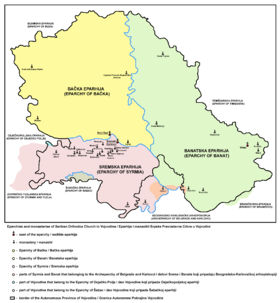
- Vojlovica monastery near Pančevo. Old monastery, founded in the 15th-16th century.
- Mesić monastery near Vršac. Old monastery, founded in the 15th-16th century.
- Središte monastery near Vršac. Old monastery, founded in the 15th-16th century.
- Bavanište monastery near Kovin. By local tradition, founded in the 15th-16th century and destroyed in 1716. Rebuilt in 1858.
- Holy Trinity monastery in Kikinda. New monastery, built in 1885-1887 as a foundation of Melanija Nikolić-Gajčić.
- Saint Melanija monastery in Zrenjanin. New monastery, founded in 1935 by bishop Georgije Letić.
- Hajdučica monastery near Plandište. New monastery, founded in 1939.
Bishops
.jpg)
.jpg)
From the middle of 16th century up to the beginning of the 18th century, under the jurisdiction of the Serbian Patriarchate of Peć, Bishops of Vršac were styled as titular metropolitans, as was customary for all diocesan bishops. Later, under the jurisdiction of the Serbian Orthodox Metroplitanate of Karlovci, diocesans of Vršac were simply styled as bishops. Title was changed from "Vršac" to "Banat" after territorial reorganization in 1931.
Bishops of Vršac
- Teodor (1594)
- Simeon (1619)
- Antonije (1622)
- Teodosije (1662)
- Spiridon Štibica (1694-1699)
- Mojsije Stanojević (1713–1726)
- Nikola Dimitrijević (1726–1728)
- Maksim Nestorović (1728–1738)
- Jeftimije Damjanović (1739)
- Isaije Antonović (1741–1748)
- Jovan Đorđević) (1749–1769)
- Vikentije Popović (1774–1785)
- Josif Jovanović Šakabenta (1786–1805)
- Petar Jovanović Vidak (1806–1818)
- Maksim Manuilović (1829–1833)
- Josif Rajačić (1833–1842)
- Stefan Popović (1843–1849)
- Emilijan Kengelac (1853–1885)
- Nektarije Dimitrijević (1887–1895)
- Gavrilo Zmejanović (1896–1919)
- Ilarion Radović (1922–1929)
Bishops of Banat
- Georgije Letić (1931–1935)
- Irinej Ćirić (1935–1936; administrator of the eparchy)
- Vikentije Vujić (1936–1939)
- Damaskin Grdanički (1939–1947)
- Visarion Kostić (1951–1979)
- Sava Vuković (1980–1985; administrator of the eparchy)
- Amfilohije Radović (1985–1990)
- Atanasije Jevtić (1991–1992)
- Hrizostom Stolić (1992–2003)
- Nikanor Bogunović (2003–present)
See also
- Serbian Orthodox Church
- Religion in Serbia
- Religion in Vojvodina
- List of the Eparchies of the Serbian Orthodox Church
References
- Ćirković 2004, p. 119.
- Palffy 2001, p. 109-132.
- Ćirković 2004, p. 141-142.
- Точанац 2008, p. 151-166.
Sources
- Шематизам Српске православне епархије вршачке за годину 1898, Вршац 1899.
- Иларион Зеремски, Српски манастири у Банату, њихов постанак, прошлост и одношај према Румунима, Сремски Карловци 1907.
- Ивић, Алекса (1929). Историја Срба у Војводини. Матица Српска.CS1 maint: ref=harv (link)
- Радослав Грујић, Духовни живот, in : Војводина (collection of papers), књ. 1, Нови Сад 1939, стр. 330-414.
- Поповић, Душан Ј. (1957). Срби у Војводини. књ. 1: Од најстаријих времена до Карловачког мира, 1699. Матица српска.CS1 maint: ref=harv (link)
- Fine, John Van Antwerp Jr. (1991). The Early Medieval Balkans: A Critical Survey from the Sixth to the Late Twelfth Century. Michigan: The University of Michigan Press. ISBN 0-472-08149-7.CS1 maint: ref=harv (link)
- Вуковић, Сава (1996). Српски јерарси од деветог до двадесетог века (Serbian Hierarchs from the 9th to the 20th Century). Евро, Унирекс, Каленић.CS1 maint: ref=harv (link)
- Stephenson, Paul (2000). Byzantium's Balkan Frontier: A Political Study of the Northern Balkans, 900–1204. Cambridge; New York: Cambridge University Press. ISBN 0-521-77017-3.CS1 maint: ref=harv (link)
- Fodor, Pál; Dávid, Géza, eds. (2000). Ottomans, Hungarians, and Habsburgs in Central Europe: The Military Confines in the Era of Ottoman Conquest. BRILL.CS1 maint: ref=harv (link)
- Palffy, Geza (2001). "The Impact of the Ottoman rule on Hungary" (PDF). Hungarian Studies Review. 28 (1–2): 109–132.CS1 maint: ref=harv (link)
- Ćirković, Sima (2004). The Serbs. Malden: Blackwell Publishing.CS1 maint: ref=harv (link)
- Точанац, Исидора (2008). Српски народно-црквени сабори (1718-1735). Београд: Историјски институт САНУ.CS1 maint: ref=harv (link)
- Ingrao, Charles; Samardžić, Nikola; Pešalj, Jovan, eds. (2011). The Peace of Passarowitz, 1718. West Lafayette: Purdue University Press.CS1 maint: ref=harv (link)
- Банат кроз векове, Београд 2010. (collection of papers)